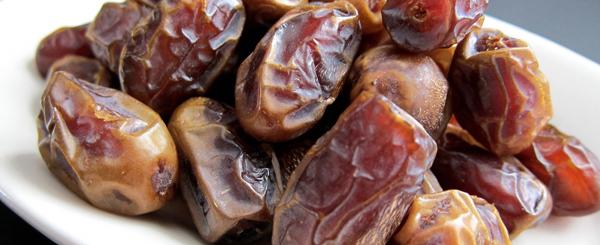DATES

Quran’ic References
Surah Abasa:
And We cause therein the grain to grow, And grapes and clover plants (i.e. green fodder for the cattle), And olives and date-palms.[80:27 – 29]
Surah Ar Rahman:
Therein are fruits, date-palms producing sheathed fruit-stalks (enclosing dates). (55:11)
In them (both) will be fruits, and date- palms and pomegranates. (55:68)
Surah An Nahl:
He causes to grow for you thereby the crops, olives, palm trees, grapevines, and from all the fruits. Indeed in that is a sign for a people who give thought. (16:11)
Dates are also mentioned in Taurat and Injil, and has been a staple food in the Middle East for thousands of years. It is the most blessed tree and synonymous with many Muslim rituals and events. For example, Rasulullah SAW advised us to break our fast with dates, for dates have plenty of barakah (blessings), and if dates are not available, then with water, because water is purification from all things. In a hadith reported by Abu Dawwud, the suhur of the Muslim is dates.
Allah SWT mentions the date palm 26 times in the Qur’an. In one of them, Maryam AS was commanded to eat dates after delivering Prophet Isa AS, and to enjoy and be happy with the dates. Due to their numerous properties and nutritious value, dates can be a complete meal by themselves. Prophets and Messengers used to eat dates, soaked in goat’s milk, as part of their regular diet. The Prophet SAW would sometimes eat nothing else for three months in a row.
A date tree takes about three to four years to bear fruit, and can live for hundreds of years. Allah used the date palm as a metaphor in surah Ibrahim, verses 24 and 25:
See you not how Allah sets forth a parable? – A goodly word as a goodly tree, whose root is firmly fixed, and its branches (reach) to the sky (i.e. very high). Giving its fruit at all times, by the Leave of its Lord and Allah sets forth parables for mankind in order that they may remember.
It is an example of the kalimah and the example of the Muslim of strength and ability to give benefits. Because the root is so deep and so strong, it cannot be shaken. The date fruit is so high that no insect can reach it. In Sahih Bukhari, Rasulullah SAW said that the date tree is like a Muslim, and the leaves of the date tree do not fall.
Benefits:
The sugar content of ripe dates is about 80%. The remainder consists of protein, fiber, and other minerals such as calcium, manganese, selenium, and zinc. Dates are rich in vitamin B, including thiamin and riboflavin.
Due to its high sugar content, dates can combat fatigue and give instant energy. They are beneficial for pregnancy and post delivery. Dates can help a mother generate more breast milk. Children who are fed with soft dates grow faster and stronger. Dates help alleviate high blood pressure and constipation.
Women consume a lot of dates before delivery find out that it helps the womb to contract, and prevents bleeding. Dates encourage the production of the hormone oxytocin, which has a lot of relationship the contraction of the womb at the time of delivery. Dates are also beneficial for the memory, the immune system, the aging process, psychological problems and weight gain.
The advice of Rasulullah SAW is considered to be a miracle because at the end of the fast, glucose and insulin levels are low and the nervous system is weak. Dates replenish and give the body all its nutritious requirements. It is one of the most complete food after milk and increases the ability of the man’s sexual performance.
It has been discovered that the dessert dwellers those who eat dates have the minimum reporting of cancer incidents, because of the magnesium content in the dates.
Other uses
In a famous hadith reported by Abu Dawwud, Rasulullah used to give new born babies soft chewed date, pass them over the lips of the baby (a practice known as tahneek).
It is also reported that if one eats seven ajwa dates in the morning, he will be protected from poison and black magic. However, bear in mind that the power does not lie in the dates alone, but the blessing of the promise.
This is just a glimpse of the many studies conducted dates. A lot of other information can be found online and in publications, and we encourage you to check them out.

